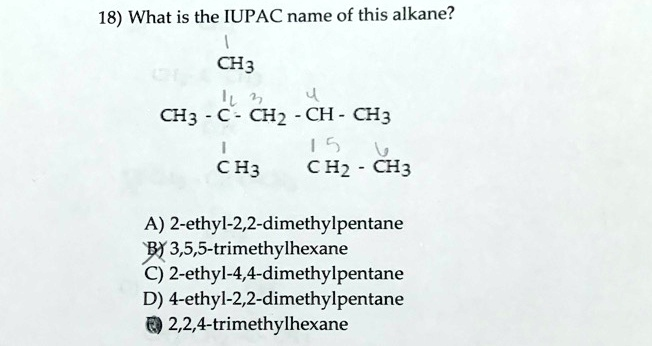What is the IUPAC name of this alkane? CH3 l CH3 – € – CH2 – CH – CH3 1 5 CH3 CH2 CH3 A) 2-ethyl-2,2-dimethylpentane B) 3,5,5-trimethylhexane C) 2-ethyl-4,4-dimethylpentane D) 4-ethyl-2,2-dimethylpentane E) 2,2,4-trimethylhexane

The Correct Answer and Explanation is:
The correct IUPAC name of the given alkane is 2,2,4-trimethylhexane, which corresponds to option E.
Let’s break it down step by step:
- Identify the longest continuous carbon chain The backbone of the compound has six carbon atoms, making the parent chain a hexane.
- Number the chain from the end closest to the first substituent Starting from the left (as shown in the image), the substituents are closer to that end, ensuring that we use the lowest possible numbers.
- Identify and name the substituent groups
- One methyl group is attached to carbon 2
- A second methyl group is also attached to carbon 2
- Another methyl group is attached to carbon 4
- Combine the name Since there are three methyl groups total (two on carbon 2 and one on carbon 4), we use the prefix tri and specify all the positions: 2,2,4. The full name becomes 2,2,4-trimethylhexane.
Explanation
This naming follows IUPAC rules which aim to make the structure of the molecule unambiguous. The first priority is assigning the longest continuous carbon chain to determine the parent name (here, hexane). The next priority is ensuring substituents are given the lowest set of locants, which is achieved by numbering the chain from the end nearest to any branch. Alphabetical order matters when dealing with different substituent types, but all branches here are methyl groups, so numbering for lowest possible digits takes precedence.
This compound does not include an ethyl group, eliminating options A, C, and D. It also does not place all methyl groups on carbon 3 and 5, ruling out option B.
So, option E is the only one that correctly and completely reflects the molecular structure
